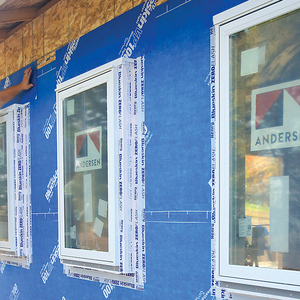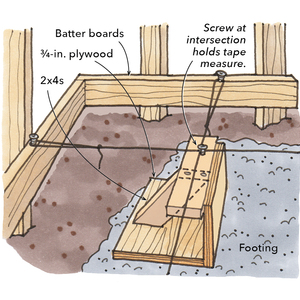Am replacing some windows for a client and while we’re at it we’ll be replacing the original siding in places (vertical shiplap pine) with same (to match the rest of the house). He’s asked if there’s anything we can do to help mitigate the street noise on one wall. That wall is ground level, 9 feet high and about 20 feet long with one 6×4 foot gliding window in the center. Wall system is typical 1970’s (2×4 studs with 1/2 inch sheathing). Insulation is likely fiberglass. I was thinking about putting a layer of 3/8″ fanfold between the sheating and the siding but have never used it under wood siding, and certainly not for sound proofing. Any thoughts?
Discussion Forum
Discussion Forum
Up Next
Video Shorts
Featured Story

A rear addition provides a small-scale example of how to frame efficiently.
Featured Video
Video: Build a Fireplace, Brick by BrickHighlights
"I have learned so much thanks to the searchable articles on the FHB website. I can confidently say that I expect to be a life-long subscriber." - M.K.
Fine Homebuilding Magazine
- Home Group
- Antique Trader
- Arts & Crafts Homes
- Bank Note Reporter
- Cabin Life
- Cuisine at Home
- Fine Gardening
- Fine Woodworking
- Green Building Advisor
- Garden Gate
- Horticulture
- Keep Craft Alive
- Log Home Living
- Military Trader/Vehicles
- Numismatic News
- Numismaster
- Old Cars Weekly
- Old House Journal
- Period Homes
- Popular Woodworking
- Script
- ShopNotes
- Sports Collectors Digest
- Threads
- Timber Home Living
- Traditional Building
- Woodsmith
- World Coin News
- Writer's Digest


















Replies
no.... you need to decouple the elements of the wall
and probably get rid of that sliding window... a triple glazed casement would have a lower sound transmission
Decouple, yeah. That's what I figured the fanfold might do, separate the siding from the sheathing without thickening the wall to much (although there'd still be contact via the siding nails. I thought about furring out the siding to put some air space in there but the siding would still be coupled via the furring strips. Casements wouldn't work here, there's zip for roof overhang plus there's an oft used path through a flower garden right along the wall. Would hate to see the HO whack his elderly head on the corner of a open window while pulling weeds. How else could one decouple the siding from the sheathing?
what about inside ?
gut the wall.. furr it horizontally... blow dens-pak cellulose adn new drywallMike Smith Rhode Island : Design / Build / Repair / Restore
Only in dreamland. The HO has floor to ceiling built in bookcases on the entire wall, all re-painted in July. That's what compelled him to look into replacing the windows, the paint job was so good it made the old windows look crappy (which they are). Poor planning on his part but gutting is not an option. I've explained to him what really soundproofing a wall would entail, but told him I'd look into other possible options. What about fanfold (or maybe cedar breather) over the sheathing then horizontal furring over that, might help the siding breath better to boot. Just a thought.
red... i wouldn't do anything.... short of extraordinary efforts on the outside OR getting rid of the window altogether..
it seems to me.. that the floor-to-ceiling books are going to do a huge job of sound absorbtion all by themselvesMike Smith Rhode Island : Design / Build / Repair / Restore
Big blocks of styrofoam on the front lawn might do it.
the more rigid a material is, the better it transfers sound... kind of like the old methoid of eavesdropping by putting a glass on the the door or wall and listening to it... the hard glass helps soundwaves transfer to your ear. Mechanics use the same principle by putting a wooden dowel, for instnace aganist their ear and touching it to parts of an engine to isolate where a noise is coming from.
so, long story short, softer materials "absorb" sound. Harder materials transfer sound.
Large areas of glass act as a huge diaphragm to transfer sound.. much like to surface of a speaker in your radio. SO those windows are likely the primary source of sound to begin with. However, multi paned windows work to dampen sound because of air layers between the sheets of glass. Airport soundproofing projects use heavy paned glass in three layers (triple paned or double paned with an added storm window configuration) to dampen sound.
To answer one of your questions, adding foam insulation behind a layer of siding will help but may not be sufficient to adequately reduce the noise level.
I would focus on the better windows and I bet the customer will love the change. There are companies who specialize in sound dampening windows for airport soundproofing that may be able to supply you with a great product.
http://www.peteforgovernor.com
Redford,For decoupling to work, you need two layers that both have some mass to them, no open holes through either layer. If the inside is drywall or plaster, you have one such layer already, the one you cannot touch! You already plan to touch the outside, so there is hope. The first thing you need to establish with the customer is a soundproofing budget.The fanfold will do almost nothing for sound. You will benefit by adding mass to the outside. For example, 2 layers of sheathing-grade (brown facing paper) 5/8" gypsum panel, fire taped, then felt and your siding, nailed to the studs with long nails. This adds 1-1/4" to your wall, and will significantly reduce transmission. Soundboard under the gypsum adds 1/2" more, and will partially decouple the assembly for a greater sound reduction. I don't know if the soundboard helps more than the second layer of mass, but I do know that walls with double drywall on one side, and a layer of sounboard on either side, seem to perform very well on paper. I have done walls with double 5/8" on one side and single 5/8" on the other, with no decoupling, and the result was surprisingly quiet.On your rolling window, get the 1/4" over 1/8" insulated glass units. They stop a lot of transmission through the glass. Stopping the noise when the window is open, now that is a research project! Good luck, and let us know how it turns out.Bill
Bill,
Thanks for the insight. I was planning to inform the client that there's probably little we can do, except maybe go for a smaller window, but will share this info. Is the gyp applied directly to the existing sheathing? Any wrap or felt between the existing sheathing and the gypsom layers recommended? I've never worked with the sheathing grade stuff but will look into it. I wonder if anyone has science on the vapor permeability of the sheathing grade drywall.
Best,
RH
(formerly Red Hen)
Hebel planks (autoclaved lightweight concrete) deaden sound. I don't suppose you could find some thin hebel sheets and lay it over the sheathing or in place of it. I believe Nichiha makes this, in sheets about a half inch thick. Claimed to be ery good as floor underlayment, too.Dual windows (not dual panes) dramatically deaden sound. You install another window, single pane, outside the one just installed. Maybe a good old fashioned storm window would serve the same function.
Redford,Yes, in your application the gypboard goes directly over the old sheathing. Only the top layer gets firetaped, to seal off the cracks. Moisture barrier needs to go on over the gypboard, so your drainage plane is just behind the siding, where it belongs. Try USG for vapor permeance info on the ext. sheathing DW.What another poster said about a separate window is very true. Better-class motels right by highways often use this method to make their rooms livably quiet. The frames are decoupled from one another, so it helps a lot in reducing transmitted noise.Bill
There is a type of window that has significantly higher insulation value than even triple pane windows. Unfortunately I haven't seen any figures on sound insulation. Even more unfortunately, the last cost figures I saw put the price way out of reach - maybe someday... The windows use a layer of Aerogel, which is the lightest solid available.
http://eande.lbl.gov/ECS/aerogels/saphoto.htm
You might try resilient channel construction with a second layer of sheathing on the exterior. Perhaps something like fiber cement siding would have enough mass that you could forego the second layer of sheathing. The fiberglass is probably doing minimal to insulate against noise. Cellulose would certainly be an improvement, but there are special insulations that will help even more.
If you really want to deaden the sound, build an adjacent wall and fill it with sand...
you might want to check out:
http://soundproofing.org/infopages/channel.htm and some of their other pages. There have also been extensive discussions of soundproofing here but, of course, they are not specific to your situation.
also: http://www.silcom.com/~aludwig/My_Music_Room.htm